©Damen,
2021
Classical Drama
and Theatre
Return to Chapters
SECTION 4: ROMAN DRAMA
Chapter 16: Late Classical Theatre and Drama
I. Introduction: Late Roman Theatre
Popular entertainment dominated the Roman stage from the turn of the millennium
until the end of the Empire, leaving in its wake next-to-no dramatic texts
of any sort from this entire period. That effectively brings to a close the
study of Roman drama, indeed classical drama itself. Added to that, the ravages
of time and the animosity of certain social forces against Roman theatre have
collaborated to erase nearly all accounts of dramatic performance in the later
Roman Empire. For some types of entertainment that comes as little surprise.
Even when scripted, professional wrestling rarely leaves behind scripts.
Furthermore, close examination of the nature of "higher" entertainment
in this day shows why its failure to be preserved comes as no surprise. Pantomime,
for instance, a highly popular form of choreographed narrative resembling modern
ballet, by definition entailed no text as such. And since talking was unnecessary,
the masks used in this genre had no openings for the actor's mouth. Introduced in 22 BCE by two actors, Pylades and
Bathyllus, pantomime came to dominate the belles-lettres of
later Rome—even though it entailed virtually no lettres, belles
or otherwise—and eventually displaced tragedy and comedy as the principal
form of serious narrative entertainment. But outside of the occasional reference
in ancient authors and a few detailed descriptions of particularly spectacular
productions, no history of pantomime survives.
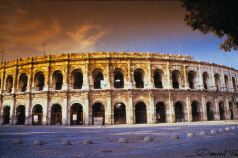 That
means we know little more about its nature than that the audience of pantomime
tended to include educated people because, no doubt, it was generally more artistic
and milder in content than its raunchier analogue, mime. Also, as a dance form,
it focused on gesture and movement and included costume changes when a performer
played different characters and often took the form of a solo danseur
with a chorus as back-up that served as the narrator of the story. What
words the chorus uttered are not preserved. And this is really all that can be said from
this distant vantage point about the pre-eminent form of dramatic art in later Rome.
That
means we know little more about its nature than that the audience of pantomime
tended to include educated people because, no doubt, it was generally more artistic
and milder in content than its raunchier analogue, mime. Also, as a dance form,
it focused on gesture and movement and included costume changes when a performer
played different characters and often took the form of a solo danseur
with a chorus as back-up that served as the narrator of the story. What
words the chorus uttered are not preserved. And this is really all that can be said from
this distant vantage point about the pre-eminent form of dramatic art in later Rome.
In general, when our sources speak of what happened in
the theatre during the majority of the imperial age, their focus is almost invariably upon non-dramatic forms of entertainment.
As today, sports commanded much attention. Besides gladiatorial combat, other
types of Roman games presented to the public included venationes,
wild beast hunts that often ended in gory kills, and naumachiae,
artificial sea battles mounted in rivers or flooded arenas. Julius Caesar himself
is said to have introduced the latter to the Romans just months before his assassination.
(note)
 The
carnage these wrought is unimaginable, and while many races and creeds met gruesome
ends to the tune of these brutal entertainments—and the victims were not
only Christians or helpless slaves—the real suffering fell upon animals
who died by the thousands on the Roman sand. Often imported from exotic locales
just so the public could have a brief look at them before their demise, creatures
of all sorts were then set at each other's throats in the arena and, while gladiators
could appeal to the crowd to spare their lives, the animals were invariably
exterminated. The ecological damage is incalculable and wholly unwarranted.
The
carnage these wrought is unimaginable, and while many races and creeds met gruesome
ends to the tune of these brutal entertainments—and the victims were not
only Christians or helpless slaves—the real suffering fell upon animals
who died by the thousands on the Roman sand. Often imported from exotic locales
just so the public could have a brief look at them before their demise, creatures
of all sorts were then set at each other's throats in the arena and, while gladiators
could appeal to the crowd to spare their lives, the animals were invariably
exterminated. The ecological damage is incalculable and wholly unwarranted.
Outside of pantomime, those few serious dramas that visited the late Roman stage entailed,
for the most part, revivals of classics. There is little evidence Romans after
the first century wrote, much less watched, original plays. Mime
lived on, of course, but rarely in a form even as erudite as "The
Adulteress." History's notation of a performance here or there burlesquing
myth or tragedy is really all that attests to the general public's awareness
classical drama had ever even existed. In that light, it is a wonder the classics
of theatre survived the age at all.
Women finally made it onto the stage, though not as serious performers but
novelty acts usually centering around their sexuality. As with earlier Greek
mime, masks were not used and performers tended to be either very good-looking
or very ugly, something extreme and eye-catching. We hear of atrocities, too,
the actual execution of criminals on stage, but it is unclear how representative
these are of what constituted the usual fare among Roman entertainments. If
an ancient author remarks on such a spectacle, it is a good guess, then, that
it was a rarity.
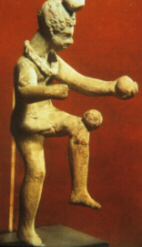 The
statuettes of jugglers and dancers preserved from Rome at this time are probably
more typical of mime in this day. So, if there is a parallel with modern life,
Roman mime probably most closely resembles modern television. To describe its
content is virtually impossible, except to say it frequently had very little worth describing.
The
statuettes of jugglers and dancers preserved from Rome at this time are probably
more typical of mime in this day. So, if there is a parallel with modern life,
Roman mime probably most closely resembles modern television. To describe its
content is virtually impossible, except to say it frequently had very little worth describing.
This cavernous absence of data makes the evolution in entertainment
across the period of late Rome hard to assess. The literary tradition that passed
the works of Euripides and Plautus, for instance, down through a succession
of Medieval manuscripts records next to nothing about these popular spectacles,
and it's not hard to see why—they probably offered little of lasting value—furthermore,
many were probably not built around written texts. Yet, to have close to nothing
from which to gauge for ourselves the nature and worth of such extravaganzas
is frustrating.
It is to our fortune, then, the sands of Egypt again step up and shed, if only
a faint light in a distant corner, at least some dim illumination on this gap
in our understanding. To wit, the scraps of an ancient papyrus have been discovered
containing fragments of dialogue drawn from what must be a late Roman skit or mime of
some sort (see Reading 9). Written
in a mixture of Greek and some unknown language, this playlet now named Charition
after its principal character—the ancient name of this piece is not preserved—has
been called a vaudeville, mostly for lack of a better word. If not great literature, Charition reveals what constituted entertainment during the age of popular taste, and it is not
an appetizing sight.
II. The End of Classical Drama
 Popular
entertainment—the games, the circuses, and the mimes—did not end
until Rome itself collapsed. Indeed, it took the complete economic collapse
of central government in the western Empire to bring a halt to the crowd-pleasing
spectacles that had dominated the theatres and sports arenas of the Roman world,
and even then only half of it. While the general shift to Christian ethics helped
undermine all forms of popular entertainment, it never squelched them entirely,
as is evident in the East where chariot racing and mimes thrived long after 476 BCE.
Popular
entertainment—the games, the circuses, and the mimes—did not end
until Rome itself collapsed. Indeed, it took the complete economic collapse
of central government in the western Empire to bring a halt to the crowd-pleasing
spectacles that had dominated the theatres and sports arenas of the Roman world,
and even then only half of it. While the general shift to Christian ethics helped
undermine all forms of popular entertainment, it never squelched them entirely,
as is evident in the East where chariot racing and mimes thrived long after 476 BCE.
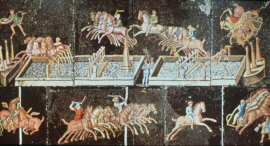 While
the period of Byzantine theatre—in essence, late Eastern
Roman theatre—really belongs to a study of the Middle Ages, it is worth
glancing at what happened to classical drama in the aftermath of antiquity,
if only to get a sense of how the story ends. Mime, in particular, appears to
have thrived in this time. Despite the failure of any script like Herondas'
to have survived from ancient Byzantium, other evidence makes it clear that
mime continued to exist well into the early modern period.
While
the period of Byzantine theatre—in essence, late Eastern
Roman theatre—really belongs to a study of the Middle Ages, it is worth
glancing at what happened to classical drama in the aftermath of antiquity,
if only to get a sense of how the story ends. Mime, in particular, appears to
have thrived in this time. Despite the failure of any script like Herondas'
to have survived from ancient Byzantium, other evidence makes it clear that
mime continued to exist well into the early modern period.
Most of the evidence for this, however, is indirect. For instance, the constant
railing of the Church fathers against the theatre in general—but, in fact,
what they were really denouncing was mime—shows the
persistence of low-brow burlesques that were probably much like Charition. Nor
did the strong grounding of ancient theatre in the polytheistic traditions of
the pagan world do much to assuage Christian leaders' fears about the potentially
corrupting influence of classical drama. In the end, to them it was better to have no
theatre at all than try to sort out the best.
III. Classical Drama after Antiquity
Furthermore, in their minds,
what little from classical drama was worth saving was best readapted to Christian
principles and thus rendered harmless to a virtuous readership, the very posture
Hrotswitha adopted toward the relatively
mild Terence. This notion can be seen in the Christus Patiens
("Christ Suffering," in the original Greek Christos Paschon),
a medieval text reconfiguring Euripides' drama, and The Bacchae
in particular, so as to tell the story of Christ, mostly by quoting the Greek
out of context or recasting the words slightly. (note)
The ready equation of Christ and Dionysus—both are youthful gods said
to have died and later been reborn, put through cruel trials and abused by detractors
(click here to
read more about this)—made the conversion less cumbersome than one
might expect. In theory, it is little different from what Plautus did with Menander,
making this Christianized Euripides just one more permutation of Greek tragedy
re-modulated for a new age and audience. (note)
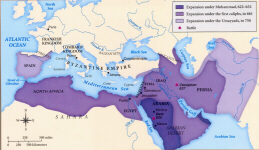 The
majority of civilizations adopted or adapted classical drama in one way or another,
with one important exception. Forged in the crucible of the early Middle Ages,
a period of dynamic cultural metamorphosis, Islam
stems largely from the genius of one man, Muhammad. An Arab
trader who had intense visions of his god Allah beginning in the early 600's,
Muhammad almost singlehandedly revolutionized the concept of religion and religious
practices in his homeland, today's Saudi Arabia. Islam entails a novel form of monotheism, one of the strongest ever conceived. (click
here to read more about this)
The
majority of civilizations adopted or adapted classical drama in one way or another,
with one important exception. Forged in the crucible of the early Middle Ages,
a period of dynamic cultural metamorphosis, Islam
stems largely from the genius of one man, Muhammad. An Arab
trader who had intense visions of his god Allah beginning in the early 600's,
Muhammad almost singlehandedly revolutionized the concept of religion and religious
practices in his homeland, today's Saudi Arabia. Islam entails a novel form of monotheism, one of the strongest ever conceived. (click
here to read more about this)
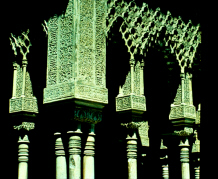 Building
from but not dependent upon earlier Christian and Jewish theological structures—and,
in particular, the ancient Hebrew scriptures known to us as the Old Testament—Muhammad
took the second of the so-called Ten Commandments, "Thou shalt not make
graven images," as an injunction against the creation of any realistic
art which included theatre, along with realistic
painting and statuary, all of which were sternly forbidden in Muslim culture. This effectively
killed the tradition of theatrical arts among the most advanced societies of
the early Middle Ages (600-1000 CE). As a result, no Islamic theatre evolved
for many centuries, either in the Near East or the many parts of the world where
Muslim culture predominates.
Building
from but not dependent upon earlier Christian and Jewish theological structures—and,
in particular, the ancient Hebrew scriptures known to us as the Old Testament—Muhammad
took the second of the so-called Ten Commandments, "Thou shalt not make
graven images," as an injunction against the creation of any realistic
art which included theatre, along with realistic
painting and statuary, all of which were sternly forbidden in Muslim culture. This effectively
killed the tradition of theatrical arts among the most advanced societies of
the early Middle Ages (600-1000 CE). As a result, no Islamic theatre evolved
for many centuries, either in the Near East or the many parts of the world where
Muslim culture predominates.
So, while the Muslims advanced the study of philosophy, mathematics, astronomy
and, as we saw in Section 1, history, Islam's suppression of drama killed the theatre for a good millennium
in the Near East which for many years was the richest and most culturally advanced
civilization on earth. Cairo, the capital of Egypt and for many centuries a
center of culture and learning, housed no theatre until the 1920's. It was, in
fact, only in the second half of the twentieth century that drama, cinema and television began to
make inroads into Islamic culture.
Other parts of the world worked more actively to keep alive the traditions
of the theatre. As Western Europe, for instance, went through economic decline
and cultural turmoil during the early Middle Ages, the memory of theatre still
lingered in the public mind, and drama was not forgotten altogether, as is witnessed
here and there in Medieval literature. In particular, mime persisted, perhaps
conveying the conventions of Atellan
farce to commedia dell'arte centuries later in the European Renaissance.
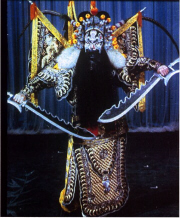 Moreover,
the theatre of China and India which never collapsed as completely as its Western
counterpart —Asian dramatic traditions have persisted basically unbroken
since their invention—has maintained a species of performance built on
a premise that views reality in ways unconventional to pragmatic Westerners. Eastern
theatre, for example, arises from a set of cultural presuppositions that aim
at and address a very different social context. That is, where the West tends
to see reality rooted in concrete and reliable terms making it sensible, observable,
measurable, and ultimately knowable, Eastern cultures have more often sought inner truths, an unchanging world accessed best through meditation and contemplation.
Moreover,
the theatre of China and India which never collapsed as completely as its Western
counterpart —Asian dramatic traditions have persisted basically unbroken
since their invention—has maintained a species of performance built on
a premise that views reality in ways unconventional to pragmatic Westerners. Eastern
theatre, for example, arises from a set of cultural presuppositions that aim
at and address a very different social context. That is, where the West tends
to see reality rooted in concrete and reliable terms making it sensible, observable,
measurable, and ultimately knowable, Eastern cultures have more often sought inner truths, an unchanging world accessed best through meditation and contemplation.
In this worldview, the material universe is merely an illusion fraught with
conflicting sensations and distractions that corrupt the mind. Truth, instead,
comes through the study of philosophy and religion, as humankind seeks the "common
spirit" found in the "real world," the world of ideas. To join
oneself with that inner truth is the goal of many Eastern philosophical and
religious systems. An outgrowth of this conception, Eastern theatre which often
looks "static" to Westerners, in fact, feeds on the perception that
immutable truths underlie all human experience. More important, theatrical conventions
grounded in such a climate have proven difficult to uproot, and thus Eastern
theatre has continued in an unbroken tradition and much better condition than
its coeval in the West.
IV. Conclusion: The Future of the Past
But to Westerners change does happen, even if it's only an illusion, so the relapse of Western civilization during the Middle Ages and its subsequent
re-formation in the Renaissance based on a new set of social institutions restored institutional theatre throughout Europe. What little of ancient
drama survived that cataclysm became a priceless resource for teaching practical
lessons in plot construction and character depiction. Had more been saved, much
time might have, too, in relearning the lessons of the past.
It seems, for instance, that the modern age is constantly re-inventing Menandrean
drama, when any particular public finally grows tired of gaudy spectacles peopled
by shallow characters and demands something "meatier" to chew on,
something that, in Horace's words, "wishes
to be in demand or called back to the stage." In other words, if we'd had
Menander from the outset of modern times, his careful guidance might have opened
our forebears' eyes and minds to the exigencies, power and possibilities of
realistic drama. With that, we might have seen our way a little faster to the
sort of drama Shakespeare created—or to be more precise, re-created.
Looking ahead, then, to Shakespeare's future is, in fact, a good way to end
this course of study and a salutary measure that sounds a final warning note worthy of Cassandra. Because we have yet to see where modern theatre is headed—and
one should recall that artforms can die out completely and so extinction is
always a threat!—Shakespeare's drama, even though it seems firmly established
in the canon of Western literature, is in reality an unfinished experiment. That
his drama still plays well on our stages today makes it appear he has ahead of him a long
and fruitful future as a classic , but our day represents only one
phase, albeit a crucial one, in his investment as an enduring feature of Western
culture, the sort of greatness his Greek tragic ancestors, despite the fact
their work now lies in "rags and patches," have already achieved.
That is, until the man from Stratford-on-Avon has withstood the turning of
the ages and as many evolutionary changes as Sophocles has seen since antiquity,
our formidable Elizabethan cousin is still a schoolboy by the standard of the
classical playwrights "with his shining morning face, creeping like snail
unwillingly" across the Western stage. No Medieval centuries, for instance,
have yet to cast the Bard as obsolete and "pagan." More important,
his language is still comprehensible to English speakers—if only barely
to many now—but all of this will change in the next few centuries, a mere
tick of the evolutionary clock, and then will come the real test of his excellence
and staying power. Let us hope for our progeny he survives his "middle
ages" better than his classical comrades did—or if not, at
least as well—for a world with no Hamlet or Bacchae
to perform is that much less worth inhabiting.
**Postscript (2023). I've been watching the latest action movie franchises featuring superheroes, for example, Spider-Man, The Avengers and the Fantastic Four, and I've noted an interesting pattern that pertains to this class. Seen from a broad perspective, these works of modern cinema alternate between fight scenes and episodes of dialogue. This is, of course, exactly the same pattern seen in classical Greek tragedy and comedy, with the exception that in the modern works fights have replaced choral songs. It is worth noting, however, that the cinematic fight scenes are, much like Greek choruses, highly choreographed and have musical accompaniment. Also, while most Greek choruses are lyric odes often to some god, there are odes that describe battles (Antigone 100-161). Thus, the legacy of ancient theatre lives on even in places where you might least expect it.**
Terms, Places, People and Things to Know
|
Pantomime
Pylades [PILL-lah-deez]
Bathyllus [BATH-uh-luss]
Venationes [venn-nah-tee-YOH-nays]
Naumachiae [now-MOCK-key-eye]
Mime
|
Charition [car-RITT-tee-yon]
Byzantine Theatre
Christus Patiens (Christos Paschon)
Islam
Muhammad |
This work is licensed under a Creative Commons Attribution-NonCommercial-ShareAlike 4.0 International License.
 That
means we know little more about its nature than that the audience of pantomime
tended to include educated people because, no doubt, it was generally more artistic
and milder in content than its raunchier analogue, mime. Also, as a dance form,
it focused on gesture and movement and included costume changes when a performer
played different characters and often took the form of a solo danseur
with a chorus as back-up that served as the narrator of the story. What
words the chorus uttered are not preserved. And this is really all that can be said from
this distant vantage point about the pre-eminent form of dramatic art in later Rome.
That
means we know little more about its nature than that the audience of pantomime
tended to include educated people because, no doubt, it was generally more artistic
and milder in content than its raunchier analogue, mime. Also, as a dance form,
it focused on gesture and movement and included costume changes when a performer
played different characters and often took the form of a solo danseur
with a chorus as back-up that served as the narrator of the story. What
words the chorus uttered are not preserved. And this is really all that can be said from
this distant vantage point about the pre-eminent form of dramatic art in later Rome. 





